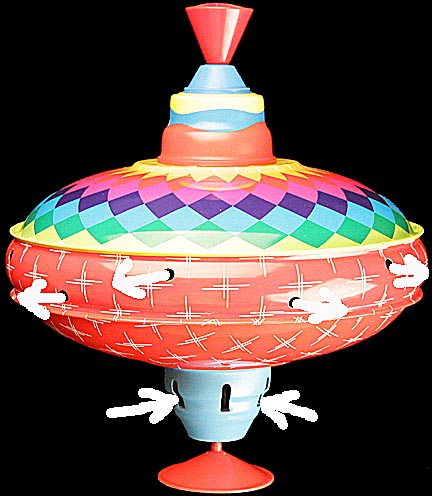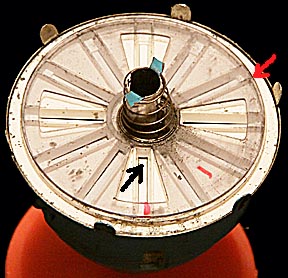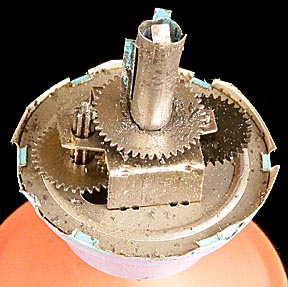

How Musical Tops Work: An explanation with pictures of how musical toy tops make music.

Once the mainstay of every child's toy closet, the classic pump top is now regarded as a nostalgia toy and is so rare that most children have no idea that they exist. However, present one of these simple wonders to any child old enough to pump the handle to make it spin and it'll take a hypnotic hold of him or her. As the top spins faster and faster it begins singing with a series of three chords that repeat over and over. Where upon the little tyke is very likely to ask, "Daddy, How do musical tops work?" While it's easy to wave one's hands in the air and explain that there are whistles inside that make the music, that doesn't explain how the air is pushed through the whistles and how the pitch of the whistles constantly changes.
When faced with just this question I attempted to find the answer on the Internet. For once Google let me down. No matter what combination of keywords I used I either got ads to purchase toy tops or information pages about top musical performers. I ran through the top 100 pages on several searches without finding a single page explaining how musical tops work. With no written explanation to be had, my only option was to tear into one to find out for myself how they worked. What I discovered was a toy that is much more sophisticated than one might assume.
Musical tops work by drawing air in through holes in the base, as indicated by lower pair of white arrows in the following image:

This air is draw up through ports in a plate between the light blue bottom and a large red body of the top, where it exits through holes along its perimeter. To understand why the air moves this way, imagine that the air inside and near the perimeter of the main red body is a baseball tied to a string. If this balls is spun around rapidly it's thrown outward. If you let go of the string it'll fly away. The air molecules are just like that baseball. Because they are being spun around by the top they pile up on the inside surface and if they are near a hole, they blow out of it drawing in air to replace them from the bottom. The reason the air comes out of the top and not the blue base is that the tendency of the molecules to spin away depends on how far away they are from the axis of rotation. Since the radius of the large red main body is larger than the blue base then it wins the tug of war and the air exits there.
(Note: Many people like to say that centrifugal force forces the air out of the holes, this being that same force that supposedly pushes you against the door of a car when you go around a curve at high speed. In fact nothing is pushing either you or the air molecules outward. In both case it's inertia, the tendency of an object to resist changes in its state of motion, that's trying to make you and the air remain where you and it are. The only force in play is centripetal force pushing both into a curved path. This goes against what so many people experience that the concept of centrifugal force is a hard one to argue against. The problem gets even more complicated because in the proper reference plane there is a reactive centrifugal force, which is equal and opposite to the centripetal force. My recommendation would be explain that because the air is spinning it wants to move outward and let the child's future high school science teacher sort out the details.)
So,
the air flows in through the blue base, up through a plate at the
top of the blue base and out through the holes in the perimeter of
the main red body. What makes musical tops "sing" is a
collection of 12 reeds in the plate, as indicated by the black arrow
in the following image:

Each reed is a thin rectangular finger that buzzes or whistles as air is drawn up through it. Slight variations in the reeds' dimensions means that they have difference pitches. They are matched in three chords of four notes each. The real question is, "How does the top change the chords?" The answer is that the blue base houses a 200-to-1 gearbox that reduces the rotational speed of the top to drive the clear plastic plate indicated above by the red arrow. As the top spins, the gears slowly rotate this disc so that it moves four windows cut into it over three different sets of reeds to produce three distinct chords. The following image shows what the gearbox looks like:

I hope this page helped explain how musical tops work for you so that if and when a child asks, you can explain it.
(Please
click on main site
to browse 100 other topics ranging from exotic kaleidoscope designs
to the strange world of lucid dreaming.)